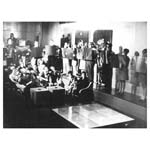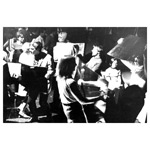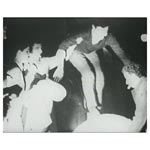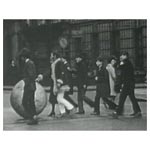In 1967 Pistoletto carried out his first actions, with which he not only emerged from the traditional spaces of art like galleries and museums, but ushered in the collective dimension of his work that was to assume growing importance over the following years.
The End of Pistoletto [La fine di Pistoletto], staged on March 6 at the Piper Pluriclub in Turin, ironically echoed in its title the slogan of the discotheque in which it was held (“Piper is the end of the world”) and at the same referred to the turning point that this action marked in his research.
One wall was lined with a number of Mirror Paintings whose subjects were friends and artists (Piero Gilardi, Clino Trini Castelli, Faustina Piacentino, Graziella Derossi) who were also frequent visitors to or organizers of the venue, an alternative disco open to staging avant-garde artistic events that had opened only a few months earlier. On the dance floor thirty people wore a photograph of Pistoletto’s face as a mask and held in their hands a sheet of reflective metal that they used to make sounds and to reflect each other’s image. These were then placed on the floor while people continued to dance. Thus the two components of the Mirror Paintings, photographic image and reflective surface, were detached from the wall and worn and brought to life by the participants in the action. One of the Minus Objects was also on show in the discotheque: the Silver Well [Pozzo argento], a meter-high fiberglass cylinder into which you could peer, observing your reflection in a mirror set at the bottom where, in an earlier version of the work, the broken canvas and frame of a painting had been placed. With its reference to the myth of Narcissus gazing at his reflection and drowning, it was a signal of a danger that had been avoided, but was still present.
In November 1967 Pistoletto met Maria Pioppi in Rome, and a month later she came to live with him in Turin, becoming his partner in life and in work. Born in Rome on October 4, 1938, she was the daughter of an antique dealer and studied at the Accademia di Belle Arti in Rome from 1956 to 1959, in particular under Toti Scialoja, whose lessons were in those years also attended by Jannis Kounellis and Pino Pascali. After living in Iran from 1961 to 1965, she returned to Rome where she worked first at Plinio De Martiis’s Galleria La Tartaruga and then at Mara Coccia’s Galleria Arco d’Alibert.
On December 4 he carried out an action entitled Walking Sculpture [Scultura da passeggio] as part of the group exhibition “Con temp l’azione”, which was held simultaneously in three Turinese galleries (Sperone, Stein and Il Punto). For this action Pistoletto utilized one of the Minus Objects, the Newspaper Sphere, a ball with a diameter of about a meter made of soaked and compressed pages of newspapers. A sphere of compressed newspapers was part of two other Minus Objects as well. One was Sphere under the Bed [Sfera sotto il letto] (1965-66), which consisted of a smaller ball, located under the artist’s bed and illuminated by a spotlight. And then there was Big Newspaper Sphere: Project for a Museum [Grande sfera di giornali: progetto per un museo] (1966), which existed at the time only as a model: the plan was to make it so big that it would occupy the whole room, and thus be impossible to take out of the exhibition space; it would eventually be realized for the Venice Biennale in 1976. On the evening of the exhibition’s opening the Newspaper Sphere was renamed Walking Sculpture and rolled along the route between the three galleries by Pistoletto and some of the other artists participating in the exhibition, including Gilberto Zorio, Mario Merz, Alighiero Boetti, Gianni Piacentino and Ugo Nespolo, as well as the curator of the exhibition Daniela Palazzoli, the gallerist Gian Enzo Sperone, the critic Tommaso Trini and some passersby. The action would be repeated in January 1968, again in the streets of Turin, this time with the participation of Maria Pioppi. Ugo Nespolo filmed the action in December and January and used the footage for the film Buongiorno Michelangelo.
Over the following decades the Walking Sculpture would be staged many times, with or without the involvement of Pistoletto. In 1993 the action was also included in the project of artistic instructions “Do It” curated by Hans Ulrich Obrist.



